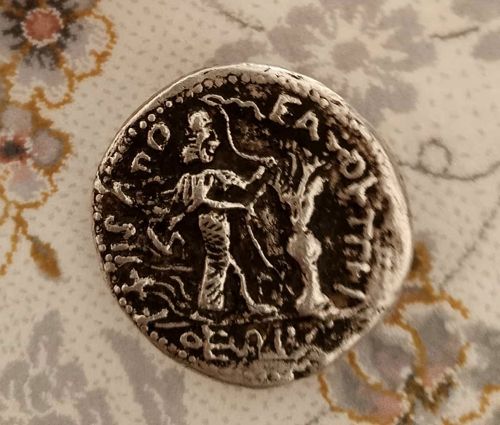Denarius, Marcus Aurelius or Commodus
Country of Origin: Roman Empire
Year of Issue: Circa 161-192 AD (based on similar examples of common reverses for these emperors)
Denomination: Denarius
Composition: Silver

Brief Description
The obverse (not pictured) would likely feature the bust of the emperor (Marcus Aurelius or Commodus). The reverse depicts a standing figure, possibly Felicitas (Felicity) or a similar deity, holding a caduceus or cornucopia, with various letters of the legend visible around the edge, likely part of 'FELICITAS AVG' or similar imperial virtues. The style suggests a somewhat crude, but common, depiction for the period.
Historical Significance
The Denarius was the primary silver coin of the Roman Republic and then the Roman Empire for several centuries. Coins from the reigns of Marcus Aurelius and Commodus are significant as they represent a period of both stability and internal strife within the Roman Empire. Marcus Aurelius's reign (161-180 AD) is often considered the end of the Pax Romana, while Commodus's reign (180-192 AD) marked a decline towards despotism, ultimately leading to the Year of the Five Emperors. These coins were crucial for daily commerce, military pay, and demonstrating imperial authority and propaganda.
Estimated Value
The estimated value of a Roman Denarius from this period can range widely based on its specific emperor, mint, rarity of the reverse type, and crucially, its condition (grade), and overall eye appeal. For a coin in the condition seen (worn, but discernible details), it could range from $50 to $250. Exceptional specimens can fetch thousands.
Care Instructions
To properly care for this ancient silver coin, handle it only by its edges to prevent transferring oils from your skin, which can damage the patina over time. Store it in a coin-safe holder, such as a Mylar flip or a non-PVC slab, to protect it from environmental damage and physical abrasions. Never clean ancient coins, as cleaning can significantly decrease their historical value and destroy the natural patina, which collectors highly value. Keep it out of direct sunlight and away from extreme temperature fluctuations.
Created At: 2025-09-06T11:04:45.015853